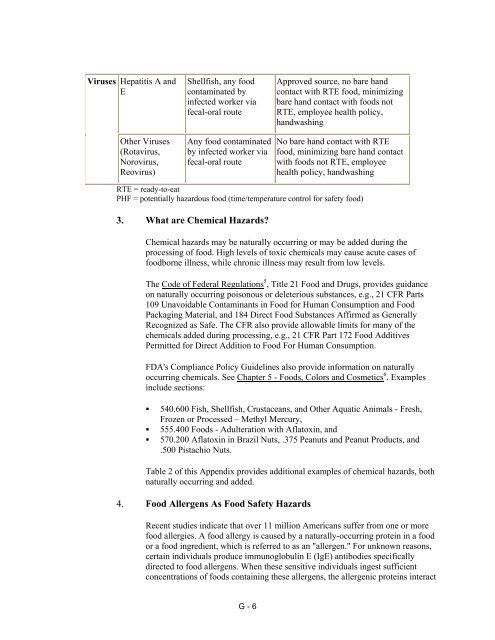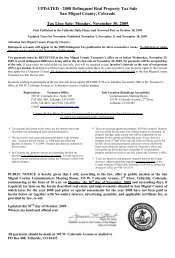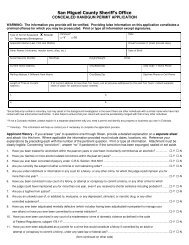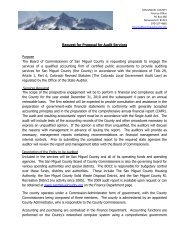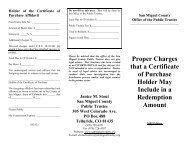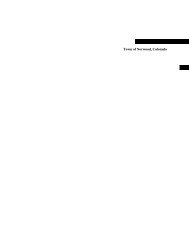colorado retail food establishment rules and ... - Boulder County
colorado retail food establishment rules and ... - Boulder County
colorado retail food establishment rules and ... - Boulder County
You also want an ePaper? Increase the reach of your titles
YUMPU automatically turns print PDFs into web optimized ePapers that Google loves.
Viruses Hepatitis A <strong>and</strong><br />
E<br />
Other Viruses<br />
(Rotavirus,<br />
Norovirus,<br />
Reovirus)<br />
Shellfish, any <strong>food</strong><br />
contaminated by<br />
infected worker via<br />
fecal-oral route<br />
Any <strong>food</strong> contaminated<br />
by infected worker via<br />
fecal-oral route<br />
Approved source, no bare h<strong>and</strong><br />
contact with RTE <strong>food</strong>, minimizing<br />
bare h<strong>and</strong> contact with <strong>food</strong>s not<br />
RTE, employee health policy,<br />
h<strong>and</strong>washing<br />
No bare h<strong>and</strong> contact with RTE<br />
<strong>food</strong>, minimizing bare h<strong>and</strong> contact<br />
with <strong>food</strong>s not RTE, employee<br />
health policy, h<strong>and</strong>washing<br />
RTE = ready-to-eat<br />
PHF = potentially hazardous <strong>food</strong> (time/temperature control for safety <strong>food</strong>)<br />
3. What are Chemical Hazards?<br />
Chemical hazards may be naturally occurring or may be added during the<br />
processing of <strong>food</strong>. High levels of toxic chemicals may cause acute cases of<br />
<strong>food</strong>borne illness, while chronic illness may result from low levels.<br />
The Code of Federal Regulations 5 , Title 21 Food <strong>and</strong> Drugs, provides guidance<br />
on naturally occurring poisonous or deleterious substances, e.g., 21 CFR Parts<br />
109 Unavoidable Contaminants in Food for Human Consumption <strong>and</strong> Food<br />
Packaging Material, <strong>and</strong> 184 Direct Food Substances Affirmed as Generally<br />
Recognized as Safe. The CFR also provide allowable limits for many of the<br />
chemicals added during processing, e.g., 21 CFR Part 172 Food Additives<br />
Permitted for Direct Addition to Food For Human Consumption.<br />
FDA's Compliance Policy Guidelines also provide information on naturally<br />
occurring chemicals. See Chapter 5 - Foods, Colors <strong>and</strong> Cosmetics 6 . Examples<br />
include sections:<br />
• 540.600 Fish, Shellfish, Crustaceans, <strong>and</strong> Other Aquatic Animals - Fresh,<br />
Frozen or Processed – Methyl Mercury,<br />
• 555.400 Foods - Adulteration with Aflatoxin, <strong>and</strong><br />
• 570.200 Aflatoxin in Brazil Nuts, .375 Peanuts <strong>and</strong> Peanut Products, <strong>and</strong><br />
.500 Pistachio Nuts.<br />
Table 2 of this Appendix provides additional examples of chemical hazards, both<br />
naturally occurring <strong>and</strong> added.<br />
4. Food Allergens As Food Safety Hazards<br />
Recent studies indicate that over 11 million Americans suffer from one or more<br />
<strong>food</strong> allergies. A <strong>food</strong> allergy is caused by a naturally-occurring protein in a <strong>food</strong><br />
or a <strong>food</strong> ingredient, which is referred to as an "allergen." For unknown reasons,<br />
certain individuals produce immunoglobulin E (IgE) antibodies specifically<br />
directed to <strong>food</strong> allergens. When these sensitive individuals ingest sufficient<br />
concentrations of <strong>food</strong>s containing these allergens, the allergenic proteins interact<br />
G - 6


